
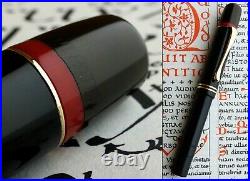
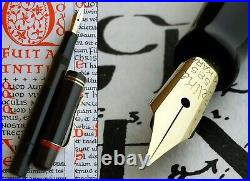
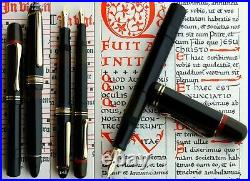
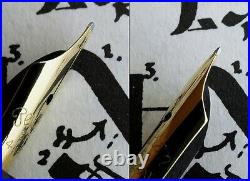
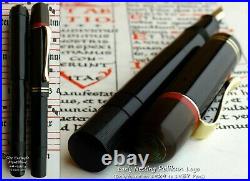
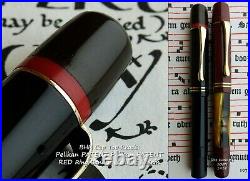
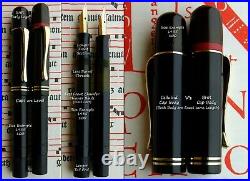
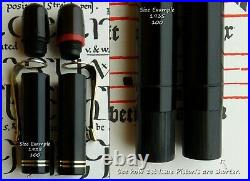
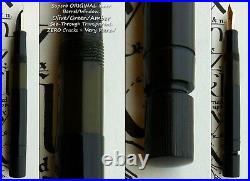
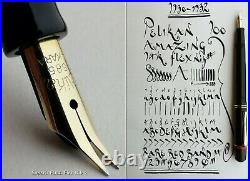

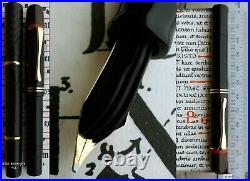

Pelikan 100 Celluloid & BHR. RED Band Fountain Pen 1931. 14K F/M Flex Nib. Made in Germany between 1930 & 1932 in this exact form. This wonderful RED Ring Band Pelikan 100 is VERY rare indeed. It has several UNIQUE features that separate it from ALL other models 100 and 100N. Firstly it has that wonderful ultra rare RED ring band above the Clip. The reason for this RED band is VERY interesting and demonstrates a UNIQUE design flaw in Pelikan 100 pens manufactured around 1930 to 1932. This factory fitted Red Band is actually an essential spacer that prevents 2 things happening, firstly prevents the nib tines tips (Iridium) twisting and damaging when the cap is screwed on tight and secondly, it prevents the Caps Breather Holes being blocked by the Top Sections internal length when screwed into the cap. This issue is because these pens have 1st issue Barrel and barrel threads and the Front Section (part you hold when writing) are shorter and so screw into the cap further than the 2nd issue/batch caps were meant to allow (1st issue caps have no Gold ring bands).. Pelikan used 2 fixes for this design flaw. These Red Band Spacers and the more commonly found twin hole cap and a longer top section internal threaded part that the nib is actually housed in when capped. By making this internal part longer it prevented the pens front section and nib screwing into the cap too far. However the problem with this fix is that the extra internal length of the top section blocked the caps essential breather holes. So those pens have a 2nd hole drilled 5mm bellow the original hole. Often these holes are wrongly mistaken for rivet style clip holes. This 2 hole fix was made the standard for this early second batch of pens. However some RARE early issue examples had this pens RED spacer Band fitted instead. I have tried to show these features in photo’s 7 & 8. The pen it is compared to is a standard Pelikan 100 that dates anywhere between 1932 and 1936. I call it a 1935 just for arguments sake. Both pens are strangely the exact same length capped however they differ in barrel, blind cap and front section length. The Red Spacer is what evens everything out. Only a TRUE 1st gen (1929 to 1930) Barrel and Front Section can fit inside this cap as it was designed. 2nd gen Barrels (1932-36) do not need the spacer. Their Barrel threads are different and their Front Sections are longer preventing the nib screwing in too far. The pen itself is made of Celluloid and BHR. ONLY the wonderful RARE 1st issue Olive/Green/Amber see through inner Barrel and its outer Binde (Black Sheath) are Celluloid. The Cap, Caps Top Section, Piston housing and Blind Cap (Tail End), Front Section (part you hold when writing) and Feed are ALL made from BHR (Black Hard Rubber). The red band is made of Casein. Has fabulous patina and crazing unique to Casein. Casein is a very early plastic made from Cows Milk. Early Montblanc White Stars are made from it also. Conway Stewart made several early Dinkie pens from Casein also. But it was mostly used for early coloured buttons and such. The pens Clip and caps Ring Bands are Yellow Gold plated and in fabulous condition. Very rare to find such clean Gold Trim on these early Pelikan’s. Rings are TIGHT and the Clip has no Plate loss etc. The pen has no Cracks, Splits or Repairs etc. Beautiful Ink window is perfect. The Black Barrel Binde is thicker on these 1st issues and has a wonderful Chamfer to the front where the cap screws up to. The 1st issue Pelikan 100 Piston is about 4mm shorter than the second batch of pistons were (1932-36). The piston has new seals fit and fills to the max every time as when new. Piston housing and Tail End have zero Oxidation. Beautiful original Black colour still. Just warmed a touch. The Cap is also a fabulous dark chocolate Black/Brown that has aged to perfection just warm enough to see it is BHR and not Celluloid. Very rare to find BHR caps this clean. The Caps ULTRA RARE top section has warmed to an even Milk Chocolate. I could remove this oxidation to make black but the Pelikan PATENT imprints are already a little worn but still readable and so I left alone. Also the Red Band is untouched. Top of Cap has the Early Nesting Pelikan Logo that dates 1929 to 1937 ONLY. Overall once in the hand to the naked eye this 92 year old looks fabulous still. This pen is EARLY Pelikan history. The real Jewel in the Crown to this rare pen though has to be it’s amazing 14 KARAT F/M flex Nib which is a simple JOY to use. Pelikan DO NOT make nibs this creative anymore. It writes with a Fine to Medium line that has Fine line side stroke at normal pressure. Perfect for everyday use. User friendly with no paper scratch etc. This nib also has flexibility that allows for even more line width variation on the down stroke when varying levels of pressure is applied. It can flex from Fine to Triple Broad. The Flex is also user friendly in that it is not soft, loose or twitchy. Only flexes upon user command never by itself. Ultra Creative Nib full of personality. A nib so creative its only real limitation is the imagination and writing ability of its user. The pens Ebonite Feed is also superb and offers fabulous ink flow qualities. Never skipped a beat during its writing test and I really push them. Superb historic rare pen that is a sensational writer. The Pelikan 100 is a fabulous and practical compact size when capped at 11.8cm or 4.7 inches. However to think of these pens as small is to not understand their design. Once the pen is posted Cap on Tail End ready to write they are actually longer than a 1930-40s Montblanc 136 or a 1950s 146 etc (see photo 3). The Pelikan 100 offers the best of both. Short enough to fit in your chest pocket or inner Jacket pocket without sticking up looking foolish like MOST modern pens do. Yet when posted (cap on tail) ready to write they are as long or longer than most so called large long pens of their ERA. 100 also have superb Width. Similar to 136, 146. The Nib is also large at size 4. In my opinion the Pelikan 100, 101, 100N and 101N are the cleverest and most important original designed pen EVER made in Germany. Certainly the most influential pen in German history. First launched in 1929. The Pelikan 100 was the FIRST pen Pelikan EVER made. I find it truly remarkable that the greatest pen ever made in Germany was their first ever attempt. Not since Leo and his Tele/Broadcaster has something been so perfect and original right off the bat, day one. Made for the everyman/woman/student/child. The Pelikan 100 was the worlds first mass produced and reliable Piston Pen. Gunther Wagner the owner of Pelikan. They developed the pen for 4 more years before release in 1929. Perhaps this is the real reason the Pelikan 100 was perfect right off the bat. It had 4 years development. Those 1929 first issue Pelikan 100 have no cap rings and are ALL Black. They also have a HEART hole nib (1929 ONLY) rather than Circle hole (1930-Present day). These heart hole nibs are the rarest of ALL Pelikan nibs. It is widely reported that those nibs were made by Montblanc. However the TRUTH is a little more complicated than that. The TRUTH is they were made by Claus Voss. Claus Voss owned a Nib manufacturing company in Hamburg. Here is where it gets interesting. Claus Voss was also the largest Shareholder and main Company Director of Simplo Montblanc. Pelikan and Montblanc were both based in Hamburg. So, the truth is Pelikan 100 Heart hole nibs were made at the same factory as Montblanc nibs. Montblanc DID NOT make nibs in its own factory. Claus Voss’s factory made nibs for several German Pen makers. Too much is made of the Heart Hole Nib 1929 Pelikan 100 being a Montblanc nib. Here is the truth. ALL Montblanc nibs were Heart Hole up to 1929. In 1930 ALL Montblanc nibs have circle hole to present day. How strange that Pelikan nibs have heart hole in 1929 and in 1930 they have circle hole same as Montblanc. The truth is ALL 1929-30’s Pelikan nibs were made by Montblanc in as much as they were made by Claus Voss factory in Hamburg. When Pelikan and Montblanc/Voss eventually had a falling out I can not say for certain but I would guess at 1935 to 1936 the relations began to sour as Montblanc started to Copy the Pelikan Piston design. MOST Pelikan writing connoisseurs argue the 1929-30s nibs are the best nibs Pelikan ever made for flex writing. Now you know why. They are in essence Montblanc size 4 nibs. Very popular size in Germany especially. Also the Pelikan 100’s length is the same as a Waterman 42 safety that was also VERY popular in France and Germany in the 1920s. So the size of a Pelikan 100 is no accident either. Yet once posted cap on tail end ready to write they are as long as most so called big pens of the ERA. The real genius to a Pelikan 100 though is its Piston design. So cheap to manufacture. ALL piston pens made today owe their function to the original Pelikan 100. The Pelikan Piston has changed very little over the years and has been in continues production since its launch in 1929. 93 years continues production. It is still the best. Even Montblanc was forced to copy the Pelikan system as their Metal Telescopic system (1936-59) was too expensive to produce. After 1959 ALL Montblanc pens use the same single action plastic piston as Pelikan designed. In fact Montblanc ONLY issued the Metal Telescopic Piston to its Meisterstuck range 13x and 14x (1936-59) all other grade 2 and grade 3 pens use the same single action piston as Pelikan designed (1935 to present day). Montblanc also copied Pelikan’s screw in Nib and Feed housing assembly design. So Pelikan has several reasons to not be happy with Montblanc. Come s ready to write just add your favourite colour bottled ink… Perfect as a gift or treat yourself to a wonderful collectible fountain pen that can be used and enjoyed daily.. Please view all the Photographs they form large part of the description. All photographs are of actual pen. What you see is everything you receive. Any boxes or papers will ALWAYS be photographed if included. Fed Ex is also available. PLEASE VIEW MY OTHER ITEMS MORE PENS, Montblanc, Onoto, Conway Stewart, Parker, Waterman, Mabie Todd Swan, Sheaffer, Dunhill etc. This item is in the category “Collectables\Pens & Writing Equipment\Pens\Fountain Pens\Pelikan”. The seller is “myhs10cd” and is located in this country: GB. This item can be shipped worldwide.
- Country/Region of Manufacture: Germany
- Nib Size: Medium (M)
- Material: Celluloid & BHR
- Features: Gold Trim
- Nib Material: Gold, 14K
- Vintage: Yes
- Personalise: No
- Brand: Pelikan

Comments are closed.
